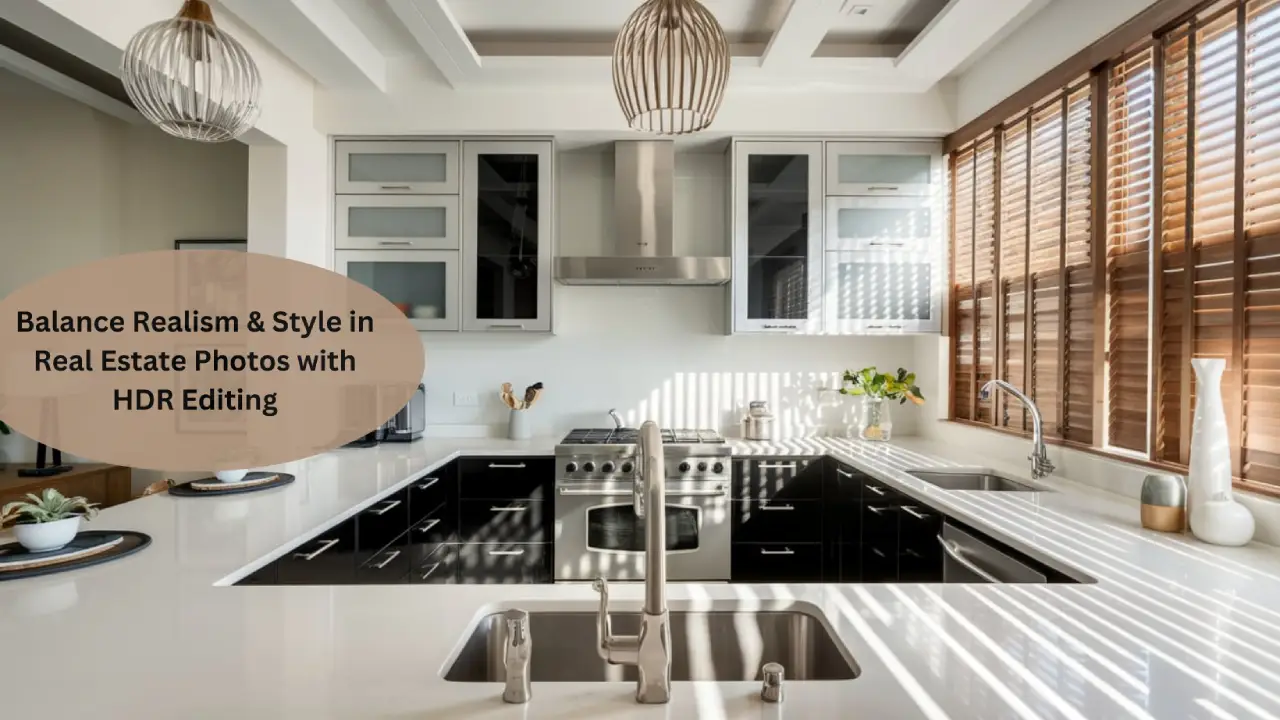The demand for HDR photo editing in real estate is soaring as traditional image editing is falling short of showcasing the natural visual appeal of the property while staying true to its actual features. By blending multiple visuals shot at different exposures, HDR image editing maintains a color balance in the real estate images, capturing the attention of interested buyers. However, editing real estate images through HDR photo editing is not as simple as it appears – you have to maintain a balance between realism and creativity for authentic representations of properties. Too much editing can overshadow the property’s features or mislead buyers, while under-edited images might not spark interest in potential buyers.
The sweet spot lies in using HDR to show properties as our eyes naturally see them, not as we wish they looked. But how do we achieve that? Let’s explore the best HDR real estate photo editing tips and techniques to balance interior and exterior exposures or achieve stylistic consistency across high-volume edits.
Techniques to Boost Visual Appeal and Creativity in HDR Real Estate Images without Overdoing It
Real estate images often showcase a wide range of light conditions – from bright sunlight peaking into the room to the darker interior spaces. When editing such images through HDR photo editing techniques, the most challenging yet critical factor is to refine specific elements without making the images look artificial or overprocessed. Here’s a look at some powerful HDR editing tips and techniques that can enhance the appeal of real estate images while maintaining their authenticity and charm:
1. Subtle Saturation Boost
- To add vibrancy to real estate images without making colors look unnatural, use hue/saturation adjustment layers in editing software like Photoshop or Lightroom. Focus on specific areas like greenery or interiors, avoiding skin tones or neutral colors like walls.
- If you have rooms with natural accents, such as wooden floors or plants, give them a fresh and inviting look by adjusting vibrance instead of saturation sliders. This provides controlled enhancement, as vibrance affects only muted colors and prevents oversaturation of already vibrant hues.
Must Read: Top 10 Best Photo Editing Services for 2024
2. Selective Sharpening
If you wish to enhance architectural details while maintaining soft areas like curtains, use selective sharpening with layer masking.
- Start by applying a sharpening filter (e.g., unsharp mask or high pass filter) to the entire image. This enhances all the details but affects both the hard and soft elements of the photo. Then, add a mask to the sharpening layer. A mask allows you to control where the sharpening effect is applied by “painting” on the image.
- Use a soft black brush to paint over areas you don’t want to sharpen, such as curtains, rugs, or other soft surfaces. Leave the sharpening effect active on edges and hard surfaces like window frames, door trims, tiles, or furniture edges. These details benefit the most from sharpening, bringing clarity and sharpness.
3. Focal Points Highlighting
To create a guided visual flow, use subtle vignettes and lighting effects so the potential buyers can notice high-value aspects of the property first.
- Add a soft vignette around the edges of the image to naturally draw attention to the center or a key feature, like a fireplace or an open patio view.
- Use radial gradient masks to selectively brighten or enhance specific areas without affecting the rest of the image.
4. Bracketing Errors Correction
Bracketing errors in HDR images usually occur when there are slight shifts between multiple image frames or movement of objects, leading to misaligned exposures and visual inconsistencies like ghosting or blurred details. Hence, it becomes crucial to correct them to ensure that the property image doesn’t appear unnatural or sloppy.
- Use cloning tools to address ghosting (double images) in areas with movement, like trees or curtains swaying.
- Align layers manually or using auto-align layers in software to fix minor shifts caused by handheld shots or tripod movement.
5. Exposure Balancing
In real estate images with large windows where both the outdoor views and the interior lighting must be showcased appropriately, balancing exposure through HDR photo editing becomes critical.
- Use tone mapping to equalize details across highlights and shadows, avoiding a flat look. Refine the brightness, contrast, and saturation sliders to reveal hidden details in dark areas while softening overly bright sections.
- Blend layers manually with layer masks to keep critical details like the view from windows while ensuring interiors remain well-lit.
6. White Balance Adjustment
Ensuring accurate white balance is critical in real estate images to create a consistent and welcoming look, especially for living rooms and kitchens. To adjust the white balance professionally in your real estate images, you can:
- Use color temperature sliders in Lightroom or Photoshop to adjust warm or cool tones until they reflect the actual ambiance of the property.
- Use gradient masks and apply selective adjustments to areas with mixed lighting (e.g., daylight from windows and warm interior lights).
Must Read: Premier Image Editing Services in India for Exceptional Results
7. Perspective Correction
Perspective issues are very common in property images, especially when photos are clicked using wide-angle lenses. The perspective correction becomes crucial in HDR real estate image editing as it provides buyers with an accurate representation of the property’s dimensions and architectural details.
- Features like lens correction in Photoshop or the transform tool can be utilized to automatically fix distortions and straighten lines.
8. Sky Replacement
In outdoor images, replacing a dull or overexposed sky with a vibrant one can significantly enhance the natural appeal and overall aesthetics of the property, making buyers more interested in that listing. Also, it can help in removing overcast, unwanted clouds, and other obstructions, depending upon the need.
- Use Photoshop’s sky replacement feature for quick swaps or manually mask the sky layer for custom adjustments.
- Match the lighting and tones of the new sky to the overall image to maintain consistency and realism. For example, a bright sunny sky pairs well with well-lit property exteriors, while a sunset sky might complement evening shots.
9. Halos Correction around Objects
HDR processing in real estate images can sometimes leave halos (unwanted bright or dark edges) around objects like trees or rooftops. Fixing such halos in real estate images is crucial as they draw attention away from the property’s actual features, reducing the image’s credibility and visual appeal.
- Use feathering tools or refine mask edges in blending software to soften transitions between layers.
- Reduce contrast or adjust brightness in overlapping areas to eliminate harsh edges.
10. Virtual Twilight Editing
Virtual twilight editing is required when the property’s best features can be showcased during the transitional evening light, but circumstances prevent actual twilight photography.
- To transform daylight images into twilight, reduce brightness, adjust color tones to warm oranges and blues, and add subtle highlights to windows or exterior lights.
- Use gradient overlays to replicate the natural shift in light during twilight hours.
Must Read: Which is the best company for photo editing and retouching?
Advanced HDR Real Estate Photo Editing Techniques for Complex Scenarios
There are certain complex cases that need to be addressed during HDR image processing in real estate. For each of these scenarios, we have outlined specific techniques:
1. Managing Mixed Lighting Sources
- Use local adjustment tools to address areas lit by different sources, such as natural daylight and artificial interior lights.
- Adjust the white balance selectively to create consistency across the image without sacrificing authenticity.
- Incorporate gradient masks to blend lighting zones naturally.
2. Window View Preservation Techniques
- Apply manual layer masking to merge window details from the correctly exposed shot with the rest of the HDR image.
- Use luminosity masking to bring back window clarity while maintaining appropriate lighting inside the room.
- Avoid over-brightening windows, as it can create unrealistic contrasts.
3. Dealing with Color Casts from Nearby Buildings
- Use selective color correction tools or hue adjustment layers to neutralize unwanted color casts caused by reflective surfaces like brightly colored walls.
- For specific areas, you can apply targeted desaturation while preserving the natural tones in the rest of the image.
4. Balancing Indoor/Outdoor Transitions
- Use Tone Mapping techniques to maintain a perfect balance between indoor and outdoor lighting so that each element can get desired attention, ensuring neither area feels over-processed or flat.
- Leverage gradient filters to balance brightness levels and create smooth transitions.
5. Seasonal Adjustments in HDR Editing
- To market real estate listings in specific seasons (e.g., winter exteriors when marketing during spring), use sky replacement and subtle tweaks for making subtle adjustments in weather tones.
- Incorporate temperature adjustments to warm up or cool down the image, matching the intended season’s feel.
- Use cloning tools to cover elements like dead leaves or snow patches with more seasonally appropriate textures.
Must Read: 10 Image Retouching Techniques Every Photographer Should Know
Challenges Involved with HDR Real Estate Image Editing
While HDR real estate photo editing solves the issue of uneven lighting and exposures, achieving precision in it is not simple – it demands proficiency in advanced image editing tools, dedicated resources, time, and infrastructure investment. A few aspects that make HDR real estate image editing challenging for professionals include:
1. Achieving Consistency across Multiple Photos
HDR images in real estate listings showcase different rooms and angles of the property to create a cohesive visual narrative. Each image might have unique lighting conditions, making it challenging to achieve consistent brightness, tone, and contrast across the entire portfolio. Inconsistent edits in such scenarios can make the property feel disjointed, impacting the overall appeal of the listing. To maintain uniformity, every image must be edited with mindfulness and precision – a time-intensive process requiring both skill and attention to detail.
2. Maintaining Scalability amid Time-Intensive Processes
Real estate HDR photo editing involves blending multiple exposures, correcting halos, merging multiple layers, and adjusting details like window views or textures. These processes are often labor-intensive, especially when handling large volumes of images for multiple properties. Scalability becomes a challenge, particularly for real estate agencies or photographers managing high-demand seasons, where ensuring consistent quality while maintaining efficiency is a necessity.
Outsourcing HDR Real Estate Image Editing – A Viable Solution to Balance Precision and Efficiency
The above-stated challenges can be easily addressed by outsourcing HDR real estate photo editing services to an experienced third-party provider. Reputed providers have a dedicated team of image editors, advanced photo editing tools, and years of experience to handle tailored requirements with efficiency and precision. They can edit bulk real estate images by adhering to your guidelines and timeline, ensuring consistency and uniformity across all pictures. Just don’t forget to check their past client work and relevant experience in your domain, along with the pricing policies.
Key Takeaway
While HDR editing relies on advanced image enhancement tools and techniques, it’s the human touch that defines the final result. Along with technical accuracy, real estate photos demand a sense of warmth and authenticity that resonates with buyers. Whether handled in-house or outsourced to experts, the goal of HDR real estate photo editing should always be to strike that perfect balance between creativity and realism. Because at the end of the day, professional HDR images don’t just showcase properties in a more appealing way—they tell a story that connects buyers to their potential home.
Must Read: Best Computers for Photo Editing in 2024





